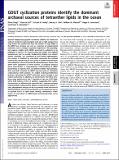GDGT cyclization proteins identify the dominant archaeal sources of tetraether lipids in the ocean
Author(s)
Summons, Roger E
DownloadPublished version (1.074Mb)
Publisher Policy
Publisher Policy
Article is made available in accordance with the publisher's policy and may be subject to US copyright law. Please refer to the publisher's site for terms of use.
Terms of use
Metadata
Show full item recordAbstract
Glycerol dibiphytanyl glycerol tetraethers (GDGTs) are distinctive archaeal membrane-spanning lipids with up to eight cyclopentane rings and/or one cyclohexane ring. The number of rings added to the GDGT core structure can vary as a function of environmental conditions, such as changes in growth temperature. This physiological response enables cyclic GDGTs preserved in sediments to be employed as proxies for reconstructing past global and regional temperatures and to provide fundamental insights into ancient climate variability. Yet, confidence in GDGT-based paleotemperature proxies is hindered by uncertainty concerning the archaeal communities contributing to GDGT pools in modern environments and ambiguity in the environmental and physiological factors that affect GDGT cyclization in extant archaea. To properly constrain these uncertainties, a comprehensive understanding of GDGT biosynthesis is required. Here, we identify 2 GDGT ring synthases, GrsA and GrsB, essential for GDGT ring formation in Sulfolobus acidocaldarius. Both proteins are radical S-adenosylmethionine proteins, indicating that GDGT cyclization occurs through a free radical mechanism. In addition, we demonstrate that GrsA introduces rings specifically at the C-7 position of the core GDGT lipid, while GrsB cyclizes at the C-3 position, suggesting that cyclization patterns are differentially controlled by 2 separate enzymes and potentially influenced by distinct environmental factors. Finally, phylogenetic analyses of the Grs proteins reveal that marine Thaumarchaeota, and not Euryarchaeota, are the dominant source of cyclized GDGTs in open ocean settings, addressing a major source of uncertainty in GDGT-based paleotemperature proxy applications.
Date issued
2019-10-07Department
Massachusetts Institute of Technology. Department of Earth, Atmospheric, and Planetary SciencesJournal
Proceedings of the National Academy of Sciences of the United States of America
Publisher
Proceedings of the National Academy of Sciences
Citation
Zeng, Zhirui et al. "GDGT cyclization proteins identify the dominant archaeal sources of tetraether lipids in the ocean." Proceedings of the National Academy of Sciences of the United States of America 116 (2019): 22505-22511 © 2019 The Author(s)
Version: Final published version
ISSN
0027-8424
1091-6490
Keywords
Multidisciplinary